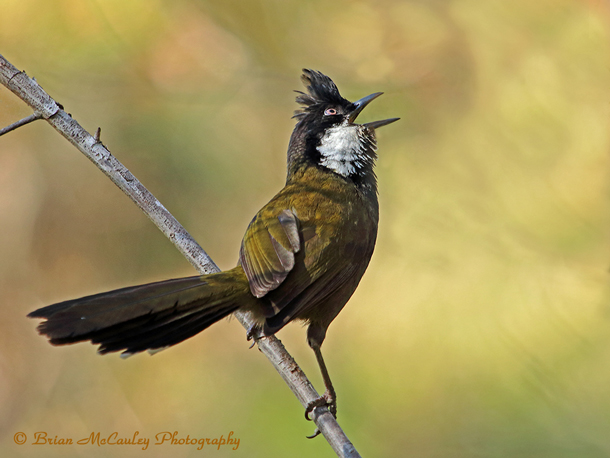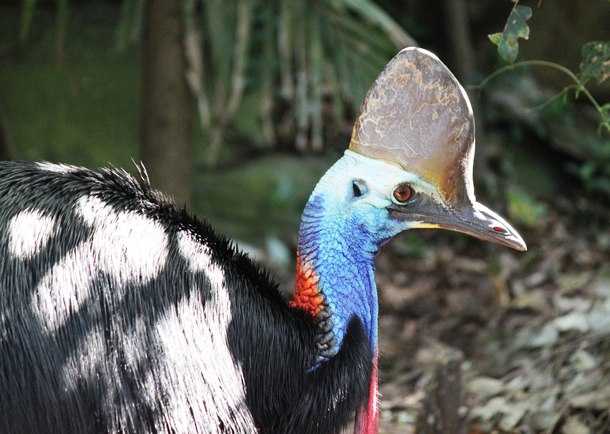BirdNote®: Australia’s Rainforest Birds
Air Date: Week of March 30, 2018

An Eastern Whipbird, which lives primarily in the understory of the Australian rainforest. (Photo: Brian McCauley)
Northeastern Australia’s rainforests are home to a number of some intriguing species, as Mary McCann describes in today’s BirdNote®.
Transcript
[MUSIC: BIRDNOTE® THEME]
CURWOOD: A visit to a far-off country can offer the chance to experience the truly exotic and unfamiliar – and as Mary McCann tells us in today’s BirdNote, that’s certainly true of the land down-under.
BirdNote®
Australia’s Rainforest Birds
[http://macaulaylibrary.org/audio/193295, 0.02-.05]
MCCANN: The rainforests of Northeastern Australia are isolated from all other rainforests on earth. As a result, they harbor many species of birds found nowhere else.
[http://macaulaylibrary.org/audio/193295, 0.02-.05]
The Eastern Whipbird hangs out in the dense understory. It’s dark, crested, 10 inches long—and more often heard than seen. Like its neighbor, the Spotted Catbird, that’s nearly a foot long and emerald-green with white spots.
[http://macaulaylibrary.org/audio/202015, 0.37-.42]
Easier to lay eyes on is the large, pigeon-like Wompoo Fruit-Dove, perching high in a tree, gulping down small fruits. Feathered in a stunning combination of green, purple, and yellow, this bird is clearly named for its voice.
[http://macaulaylibrary.org/audio/202015, 0.37-.38]
While pig-like grunting on the forest floor tells us we’re in the company of the largest bird on the continent—the Southern Cassowary.

A Southern Cassowary, the largest bird found on the Australian continent. (Photo: OZinOH)
[http://www.xeno-canto.org/species/Casuarius-casuarius]
On average, the female weighs 130 pounds and stands around 5 feet tall, looking like a giant, lush, black hairpiece on thick legs.
[http://www.xeno-canto.org/species/Casuarius-casuarius]
A helmet called a casque makes it look as much like a dinosaur as any living bird.
[http://www.xeno-canto.org/species/Casuarius-casuarius, first recording in list]
I’m Mary McCann.
###
Written by Bob Sundstrom
Bird sounds provided by The Macaulay Library of Natural Sounds at the Cornell Lab of Ornithology, Ithaca, New York: Eastern Whipbird [193295] recorded by David A McCartt; Spotted Catbird [189064] recorded by Cedar A Mathers-Winn; Wompoo Fruit-Dove [202015] recorded by Emma I Greig.
Southern Cassowary recorded by Marc Anderson, sourced from
http://www.xeno-canto.org/species/Casuarius-casuarius
Producer: John Kessler
Executive Producer: Dominic Black
© 2005-2018 Tune In to Nature.org March 2018 Narrator: Mary McCann
http://birdnote.org/show/australias-rainforest-birds
CURWOOD: Burrow on down to our website, loe dot org, to see some photos and learn more.
Links
This story on the BirdNote® website
The call of the Eastern Whipbird
Living on Earth wants to hear from you!
Living on Earth
62 Calef Highway, Suite 212
Lee, NH 03861
Telephone: 617-287-4121
E-mail: comments@loe.org
Newsletter [Click here]
Donate to Living on Earth!
Living on Earth is an independent media program and relies entirely on contributions from listeners and institutions supporting public service. Please donate now to preserve an independent environmental voice.
NewsletterLiving on Earth offers a weekly delivery of the show's rundown to your mailbox. Sign up for our newsletter today!
 Sailors For The Sea: Be the change you want to sea.
Sailors For The Sea: Be the change you want to sea.
 The Grantham Foundation for the Protection of the Environment: Committed to protecting and improving the health of the global environment.
The Grantham Foundation for the Protection of the Environment: Committed to protecting and improving the health of the global environment.
 Contribute to Living on Earth and receive, as our gift to you, an archival print of one of Mark Seth Lender's extraordinary wildlife photographs. Follow the link to see Mark's current collection of photographs.
Contribute to Living on Earth and receive, as our gift to you, an archival print of one of Mark Seth Lender's extraordinary wildlife photographs. Follow the link to see Mark's current collection of photographs.
 Buy a signed copy of Mark Seth Lender's book Smeagull the Seagull & support Living on Earth
Buy a signed copy of Mark Seth Lender's book Smeagull the Seagull & support Living on Earth

